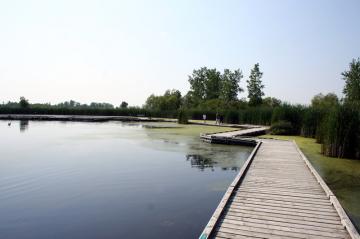Fort Whyte Alive

Park Size: 259 hectares
Difficulty: Easy - Family
Park Amenities:
Fort Whyte Alive is a year round nature park, activity destination, wildlife refuge and a not-for-profit learning centre providing educational and environmental nature programs located in the City of Winnipeg, Manitoba, Canada.
The nature park measures over 259 hectares (640 acres). There is a reception centre, interpretive centre, day use picnic area, 7 kilometres of interpretive hiking trails, floating boardwalks, bird houses, five lakes, wetlands, fishing pond and a 28.3 hectare (70 acre) bison refuge (said to be the largest urban herd in Canada).
The trails and lakes of Fort Whyte Alive provide year round adventures. In the summer visitors enjoy self guided and guided tours, hiking, birdwatching, sailing, canoeing, kayaking, wildlife watching, picnicking, sightseeing and fishing for pike, walleye and trout. And there are canoe and rowboat rentals available if need be.
During the winter months, after the lakes freeze over and the snow has fallen, other activities enjoyed include snowshoeing, xc skiing and tobogganing. There are snowshoe rentals available in the reception centre.
The Alloway Reception Centre is the first to welcome all visitors to Fort Whyte Alive. The complex is home to the Nature Gift Shop, Buffalo Stone Cafe, information racks, conference rooms and meeting facilities suited for groups, day camps, educational programs and environmental functions.
The other main facility on site is the Interpretive Centre located on the shores of Lake Devonian. The centre is a 10,000 square foot complex housing exhibits, dioramas and displays.
Some of the main features in the Interpretive Centre include the Prairie Partners Exhibit (prairie dogs), Glass Honeybee Hive, Aquarium of the Prairies (largest indoor aquarium in Manitoba, Canada), Climate Change Exhibit, Carbon Lite Theatre and the Touch Museum.
The 7 kilometres of interpretive hiking trails provide an opportunity for wildlife watching, birdwatching and visiting other attractions located in the nature park like the Tipi Encampment, Settler Sod House, Saturn Family Tree House, Bison Herd, Tall Grass Prairie, Fort Whyte Farms and the Prairie Dog Town.
The trails include the Janice Raleigh Pond Trail (0.5 kms), Jansson Forest Song Trail (0.8 kms), Wetland Boardwalk Trail (1.0 kms), Carolyn Sifton Trail (2.0 kms) and the Green Corridor Trail (4.6 kms).
Most of the trails are easy-going and level paths suitable for all ages and fitness levels. The trails are well signed... while the shorter trails form loop routes making navigation and sightseeing easy. Trails are not paved nor wheelchair friendly.
Each trail has highlights. The Jansson Forest Song Trail leads to Lake Muir and the Loly Lookout Picnic Site. The Carolyn Sifton Trail visits the shores of Lake Cargill. The Wetland Boardwalk Trail explores floating boardwalk trails crossing lakes. The longest trail - Green Corridor Trail - explores all habitats including the bison herd and please make note - it may be challenging for some individuals.
For birdwatchers the trails of Fort Whyte Alive lead to some great opportunities for bird sightings. There are opportunities to view waterfowl, song birds and predator birds. In the fall the nature park is a migratory destination for Canada Geese and various species of ducks.
Some of the various types of birds sighted at Fort Whyte Alive include loons, thrashers, grebes, thrushes, pelicans, kinglets, herons, bitterns, wrens, nuthatches, jays, swans, ducks, swallows, larks, flycatchers, eagles, hawks, falcons, owls, woodpeckers, kingfishers, coots, plovers, sandpipers, terns, hummingbirds, swifts, cuckoos, pipits, waxwings, vireos, warblers, grosbeaks, sparrows, blackbirds, orioles, finches and doves.
Address:



